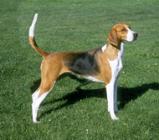
This is a placeholder text
Group text
by marshies on 23 March 2010 - 08:03
Before you ask, though I have not bred dogs, I have studied Mendelian genetics for quite a while. The great thing about acadamia versus personal breeding experience is, if someone gets a result, someone else can recreate the result and prove it not to be fluky. Moreover, this result can be proven as constant over time if enough people can recreate it successfully. Seeing as most of modern life's great amenities comes from academic study of a certain subject, I disagree that it should be discounted in dogs breeding. If Medelian genetics can be applied from fruit flies to humans, it can be applied to dogs.
So to simplify the explaination on why recessive:
The mother has Aa, with big A being the dominant allel (the expression of a gene), and a being the recessive.
The father also has Aa.
Here, both physically express the same traits because the dominant allel will be expressed.
Of course, these stipulations can be changed to match your dog. In real dogs, its much more complicated, and I recommend reading on http://en.wikipedia.org/wiki/Punnett_square as a more adequate introduction to how genetics is determined by Mendel. And he has bred peas, fruit flies, etc, to back his work.
So the offspring has the possibility of having the following genetic combinations:
| Mom/Dad | A | a |
| A | AA | Aa |
| a | aA | aa |
In this simple scenario, with only 2 allels for each gene and only 1 gene in the parent, there is a 25% probability for having the recessive and 25% for having the complete dominant. The majority goes towards having a dominant expression with the ressesive allel still in the genes. If you look at the link I sent you, you'll see that it's more complicated in even peas with 2 different types of traits, never mind a dog with a billion.
So say the mother has 4 puppies, then based on probability, only 1 will have the AA genes. The other 2 siblings will exhibit the same features, but still carry the recessive gene. This last puppy expressing the recessive gene is, I'm assuming, the one you'll cull.
You may point at my diagram and say I've just helped you prove your point that with culling, the breeding will work. However, that is not what this square is saying.
This square applies to ALL dogs who express a certain trait. So there is really no justification to inbreed when the link I send you will lead you to a more complex 4 trait crossing, and show you that the chances of expressing more recessive traits will go up when you bred dogs with similar genetic background.
On a macro level, linebreeding and inbreeding also reduces genetic diversity and renders these dogs more succeptible to new diseases and pests. This phenominon has been observed in every type of breeding, from fruitflies ot humans. Adaptability is the key to survival, and adaptability, in nature, comes from genetic variation across time.
What I'm posting is in no way to discount the fabulous breeding work you may have done. I'm merely posting it to explain that there is sound science behind genetics, and that individual results have an element of probabil
by Lief on 23 March 2010 - 10:03
Contact information Disclaimer Privacy Statement Copyright Information Terms of Service Cookie policy ↑ Back to top




